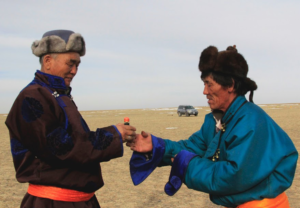
MONGOLIAN CULTURE
 Mongolian culture is well known for its nomadic traditions. And it’s one of the last few places on the planet where nomadic life is still a living tradition.
Mongolian culture is well known for its nomadic traditions. And it’s one of the last few places on the planet where nomadic life is still a living tradition.
The nomadic way of lifestyle is still practiced today in the rural areas of the country.
For 3 000 years, the people of the steppes have adopted a pastoral way of life moving in the search of best pastures and campsites. Mongolians raise their five domestic animals (sheep, horses, cows (yaks), camels, and goats). They raise them in the broad region of forest, steppe and Gobi desert.
Mongolian nomadic people move into place to place 2-4 times a year as well as it is depending on livestock’s pasture. And their the most popular dwelling is yurts or sometimes it’s called GER.
Mongolians love their horses and they see their horses are their best friends. Mongolian horses serve as riding and transport animals. And use them both for the daily work of the nomads and in horse racing.
So, you can’t imagine Mongolian nomad families without horses and the horse riders love to gallop and sing loudly in a vast steppe. It’s their joy. That’s why there many great songs about horses in Mongolia.
Music of Mongolia
The music of Mongolia is pretty rich with a variety of types. There is also unique music which are long songs and overtone singing.
Nowadays a heavy metal band called ” The Hu” is getting millions of youtube views and has become famous to the world. Here is their video link to watch:
Mongolian Language
Mongolian is an official language in Mongolia. It belongs to the Ural-Altaic language family. In Mongolia, the Khalkha dialect, written in Cyrillic, is predominant. The ancient Mongolian script, also known as Uyghurjin, was the first writing system created specifically for the Mongolian language, and was the most successful until the introduction of Cyrillic in 1946.
The most popular religion Mongolia is Buddhism so, according to the national census of 2010, 53% of the Mongolians identify as Buddhists, 38.6% as not religious, 3% as Muslims (predominantly of Kazak ethnicity), 2.9% as followers of the Mongol shamanic tradition, 2.2% as Christians and 0.4% as followers of other religions. Other sources estimate that a significantly higher proportion of the population follows the Mongol ethnic religion (18.6%).
Mongolian yurt/ger is one of the oldest dwellings in a nomadic lifestyle. Ger means home in Mongolian. Yurt is a Russian word for ger and it’s more popular word for ger. Basically, a frame of a yurt consists of a center ring (toono), rafters (uni), lattice walls (hana), a door and its frame (haalga) and 2 pillars. And there are top and side covers, inner and outer linens, ropes twined camel or yak wool.
